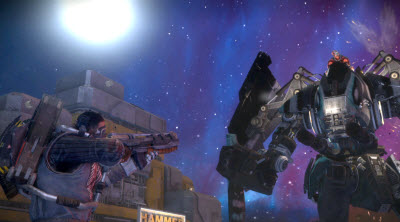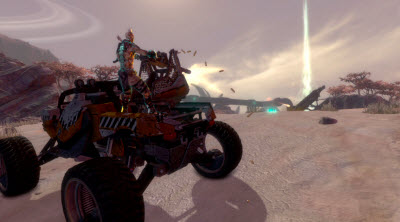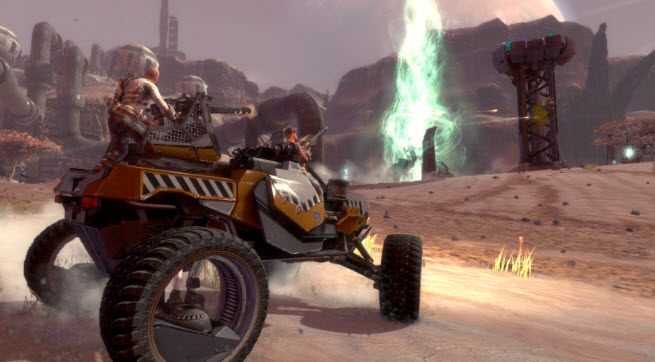GamesBeat: What would you say is the best sales pitch you’ve got for people who don’t know what Starhawk is about, who are considering getting into it?
Jobe: Weird as it sounds, one of the main reasons we designed Warhawk the way we did was a direct response to what we felt was happening in the shooter genre. We felt there was a stagnation. We felt that the shooter genre had just basically turned into a game of one-upsmanship when it comes to the linear consumption of showpiece moments, running down the hall, see a showpiece, shoot a guy in the face, run down the hall, over and over again. So we took a lot of risks with Starhawk, with our space Western vibe, the build mechanics, and the battle mechanics.
I think all of that being said, the high level sales pitch to someone who’s a shooter fan but not familiar with Starhawk is, ‘If you’re a shooter fan and you want to try something new, truly new, take a look at Starhawk. Because it’s not your average shooter, and it’s not your average shooter because of the build and battle system. Basically, instead of having you go through a series of linear missions, making weapon selections and cover selections, you’re actually creating your own cover because you can build your own choke points with connecting walls, or build your own towers, build your own bunkers, summon your own artificial intelligence (AI) allies. You can create Razorback 4-by-4s and other vehicles in garages that you create. So it really kind of blends a shooter and realtime strategy together in a way that still feels really fast and visceral.
 GamesBeat: My joke for you is, maybe you ought to try to market Starhawk to the people who played Rage.
GamesBeat: My joke for you is, maybe you ought to try to market Starhawk to the people who played Rage.
Jobe: Ha ha ha. Maybe?
GamesBeat: They didn’t have such a great multiplayer component to their game.
Jobe: Yeah. That’s true. I must admit, I was surprised at the car combat aspect.
GamesBeat: There’s some similarity, so people who liked that game might also like this too.
Jobe: We certainly put a lot of our effort into the multiplayer. One thing is for certain: We agree that in the contemporary shooter market, multiplayer matters. What keeps people playing the shooter games for thousands of hours is the sticky multiplayer gaming, the community tools, and all of that stuff. So we definitely, even in Starhawk, put an emphasis on multiplayer. But our single-player campaign is good. Some people thought it might just be a glorified multiplayer tutorial where you play capture the flag with bots. That’s not it at all. There’s a really cool story there about Emmett Graves in our space western universe. It’s an analog to the Gold Rush in the early American West, except that in our universe the human colonists are after what we call “blue gold,” these geysers of blue energy. That’s ultimately the MacGuffin, the catalyst for the conflict in the universe.
 GamesBeat: How about the comparisons to Warhawk? What did you learn from that, and how have you made this different?
GamesBeat: How about the comparisons to Warhawk? What did you learn from that, and how have you made this different?
Jobe: We learned a lot from Warhawk. Warhawk was a pioneer in some respects, because if you remember back at that time, which feels like forever ago, the whole notion that you would be able to download a big-budget game was kind of crazy. People at the time thought, “Oh, it’s a game that you download so it must be a small game. It can’t be a big game, it can’t be fun, I can’t be playing it for hundreds of hours.”
But in fact that was totally not the case. And now when you think about downloading a game, whether it be off Xbox Live Arcade or Steam or whatever, you don’t even think twice about it. We learned a lot of stuff on the multiplayer side in Warhawk. But I think, in many respects, one of the key multiplayer learnings was that single-player really does matter. Above and beyond the desire to steep players in the universe and the fiction and all of that stuff. It actually gives players a very safe place to get acclimated to the game systems.
Because adversarial multiplayer is an unforgiving place. Making sure that single-player is a good compelling experience, but also making sure that it gives them an opportunity to understand the game and get good with it before they go online, ended up being key. In Warhawk of course we didn’t have a single-player campaign, so players were essentially thrown to the wolves right off the bat, which made the experience very unforgiving. For those players who kind of stumbled through it, they were able to find some really exciting multiplayer experiences, but that learning curve was really steep in Warhawk. I think that’s one of the things that we changed significantly in Starhawk.
One of the other big changes that we did, to help make more informed design decisions about balance, was putting in place a really massively robust backend system for game analytics. We’re able to track far more statistics than we ever could. We’re a game studio in Austin, right? In the heart of a lot of social gaming and indie games and Facebook apps and all of that. Analytics is king. With it, you can make some really amazing business decisions, and also really smart, well-informed design decisions. We invested a lot of time putting in place a great telemetry system in Starhawk. We track every single event for every player in every game on the planet every single day. We know what skill you activated, when, how long you had that skill activated, when you switched.
We know every kill that every player made, where they were, how they made it. We know how many structures are being built, where they’re built. Down to very specific game design and tuning parameters, like, for every missile that is fired at another aircraft, we know how their controller was configured. Did they attempt to dodge it? If they attempted to dodge it, were they successful or were they not? So that we can make sure that the different control schemes have balance and are not providing advantages one way or another.

